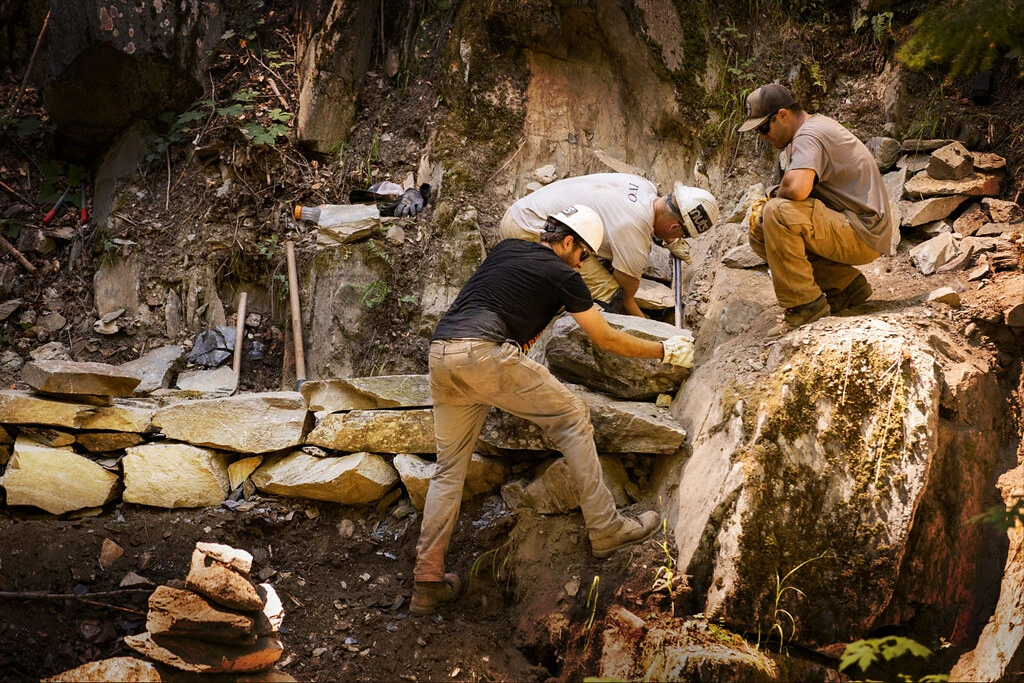
reasonstobecheerful.world
Building More Than Trails
There is some debate as to where the name “The Lost Sierra” comes from‚ but it’s become the common name — and an apt one — for the lesser-traveled towns‚ alpine lakes and peaks near Reno‚ Nev. and within the northern reaches of eastern California’s Sierra mountains.
More than a dozen communities are tucked away across this area‚ which is fragmented by the mountainous terrain of the surrounding national forests and‚ more recently‚ by extreme wildfire.Â
Over the past few years‚ Trinity Stirling‚ who lives in Quincy and grew up in the Lost Sierra‚ has made it her mission to help connect these scattered communities with the hopes of giving their economies a boost by creating more recreation opportunities. And that mission starts with trails.Â
The Sierra Buttes Trail Stewardship Trail Crew building a solid trail foundation in steep terrain. Credit: Ken Etzel
As the former project manager with the Sierra Buttes Trail Stewardship‚ Stirling worked on a long-term project to connect more than a dozen rural towns with a long-distance trail stretching about 600 miles. Stitched across federal public land‚ the trail network is coming together in stages‚ building off existing trails. So far‚ about 74 miles are under construction and 30 miles have been finished —Â with broad support for building more. “A lot’s happening‚” says Greg Williams‚ the group’s executive director. For now‚ he says the biggest challenge is funding.
The goal of the Lost Sierra Route‚ as the long-distance trail will be known‚ is to improve access to public land at a time when more and more people want to get outside‚ while at the same time connecting isolated communities and working to diversify the regional economy‚ which grew around the booms and busts of natural resource industries like mining‚ logging and ranching.Â
“Obviously we’re connected by roads‚” Stirling says. “We have a lot of dirt roads. But one of the early concepts for this project‚ once it’s built‚ is creating a community passport.” The passport would encourage trail users to travel from town to town‚ checking out different businesses and getting a sense of the varied places connected to the trail system.Â
Historic buildings of downtown Quincy in the fall. Credit: Patrick Cavender
Already‚ the region is seeing success in building out a stable recreation economy. It’s a popular spot for mountain bikers‚ who are drawn to existing trails and races like the annual Downieville Classic‚ which Williams created in 1995. Williams‚ who started the stewardship group in 2003‚ says as he worked on more trail projects‚ there was increasing interest in a regional system.Â
“We’d go to Board of Supervisor meetings or Chamber of Commerce meetings and neighboring towns would say‚ ‘Hey‚ what about us? We’re struggling. We’re surrounded by national forests. We live in a beautiful place that we feel like people want to come [visit]‚’” Williams recalls.Â
Williams points to Quincy‚ a town of about 1‚600 people surrounded by national forest land‚ as a strong indicator for the potential in creating more recreation opportunities. “Quincy just had a brewery-restaurant open. So now there are two brewery-restaurants in town that didn’t exist before trails were there‚” he says. “The local motels are buying new mattresses and painting the sidings…. So we’re seeing it happen.”Â














